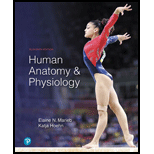
Nursing Student with Neuropathic Pain
Tamara Costa broke her right tibia and has undergone two separate surgeries to repair it. Although the bone has healed, she suffers increasing pain around the incision sites. The painful area covers the lateral surface of her right leg. She can't stand wearing anything over it or even having a sheet touch it. Her diagnosis is postsurgical neuropathic pain. Pain medication has not helped.

Tamara is a second-year nursing student and has done some reading to try to understand her problem and perhaps find a solution. She has found an article that says neuropathic pain may be caused by a decreased threshold for action potential generation in pain-detecting neurons. However, she has forgotten some of her physiology and needs some help in understanding what she is reading. She has logged into the “Ask a Nurse" chat line–and she got you!
5. You’ve found a copy of the same article, and see that it identifies other ways pain inhibition could decrease. Explain each of them:
a. A decrease in the number of receptors for the inhibitory neurotransmitter GABA.
b. A local decrease in the amount of Cl-outside the cell. (Hint: GABA opens Cl–channels, allowing Cl– influx into the postsynaptic cell.)
Want to see the full answer?
Check out a sample textbook solution
Chapter 11 Solutions
Human Anatomy & Physiology (11th Edition)
- Other than oil and alcohol, are there other liquids you could compare to water (that are liquid at room temperature)? How is water unique compared to these other liquids? What follow-up experiment would you like to do, and how would you relate it to your life?arrow_forwardSelection of Traits What adaptations do scavengers have for locating and feeding on prey? What adaptations do predators have for capturing and consuming prey?arrow_forwardCompetition Between Species What natural processes limit populations from growing too large? What are some resources organisms can compete over in their natural habitat?arrow_forward
- Species Interactions Explain how predators, prey and scavengers interact. Explain whether predators and scavengers are necessary or beneficial for an ecosystem.arrow_forwardmagine that you are conducting research on fruit type and seed dispersal. You submitted a paper to a peer-reviewed journal that addresses the factors that impact fruit type and seed dispersal mechanisms in plants of Central America. The editor of the journal communicates that your paper may be published if you make ‘minor revisions’ to the document. Describe two characteristics that you would expect in seeds that are dispersed by the wind. Contrast this with what you would expect for seeds that are gathered, buried or eaten by animals, and explain why they are different. (Editor’s note: Providing this information in your discussion will help readers to consider the significance of the research).arrow_forwardWhat is the difference between Uniporters, Symporters and Antiporters? Which of these are examples of active transport?arrow_forward
- What are Amyloid Fibrils? What biological functions are these known to perform?arrow_forwardHow do histamine and prostaglandins help in the mobilization of leukocytes to an injury site? What are chemotactic factors? How do they affect inflammation process?arrow_forwardCompare and contrast neutrophils and macrophages. Describe two ways they are different and two ways they are similar.arrow_forward
- Understanding Health Insurance: A Guide to Billin...Health & NutritionISBN:9781337679480Author:GREENPublisher:Cengage
 Medical Terminology for Health Professions, Spira...Health & NutritionISBN:9781305634350Author:Ann Ehrlich, Carol L. Schroeder, Laura Ehrlich, Katrina A. SchroederPublisher:Cengage Learning
Medical Terminology for Health Professions, Spira...Health & NutritionISBN:9781305634350Author:Ann Ehrlich, Carol L. Schroeder, Laura Ehrlich, Katrina A. SchroederPublisher:Cengage Learning  Comprehensive Medical Assisting: Administrative a...NursingISBN:9781305964792Author:Wilburta Q. Lindh, Carol D. Tamparo, Barbara M. Dahl, Julie Morris, Cindy CorreaPublisher:Cengage Learning
Comprehensive Medical Assisting: Administrative a...NursingISBN:9781305964792Author:Wilburta Q. Lindh, Carol D. Tamparo, Barbara M. Dahl, Julie Morris, Cindy CorreaPublisher:Cengage Learning





